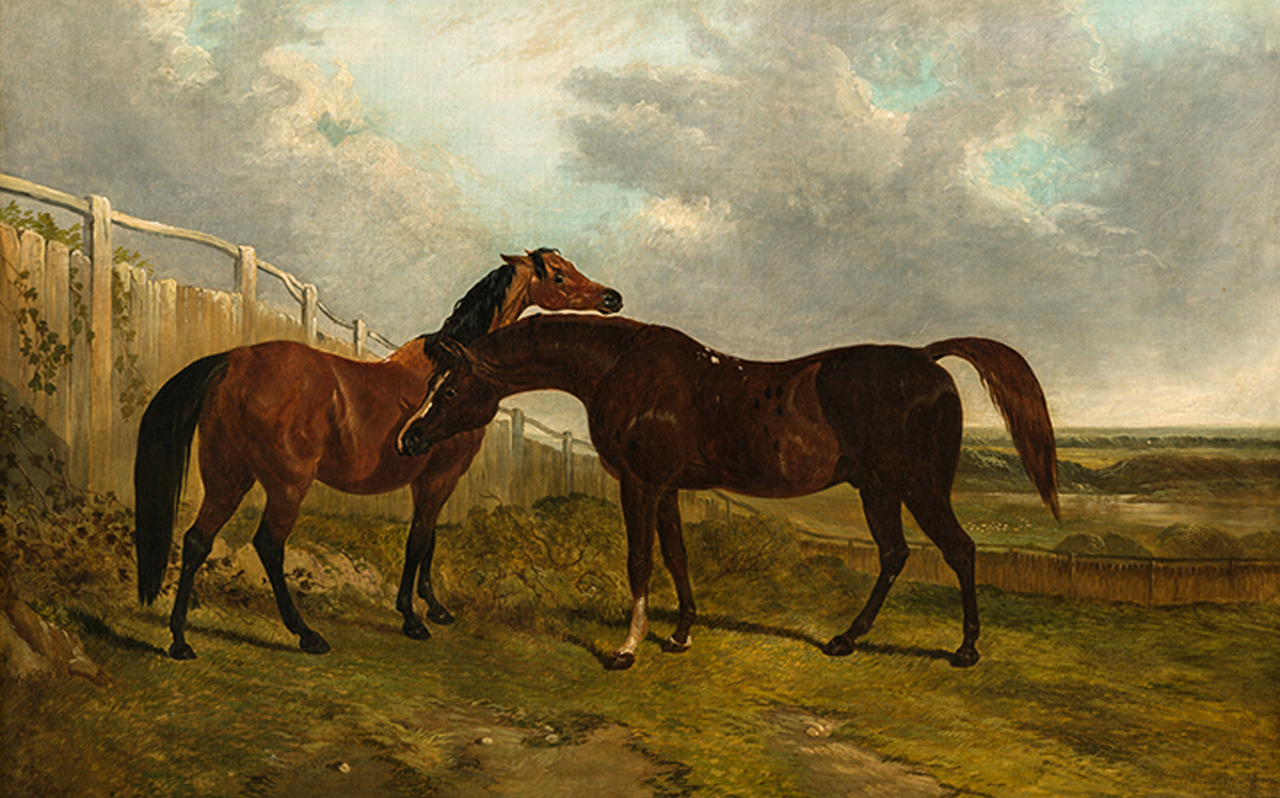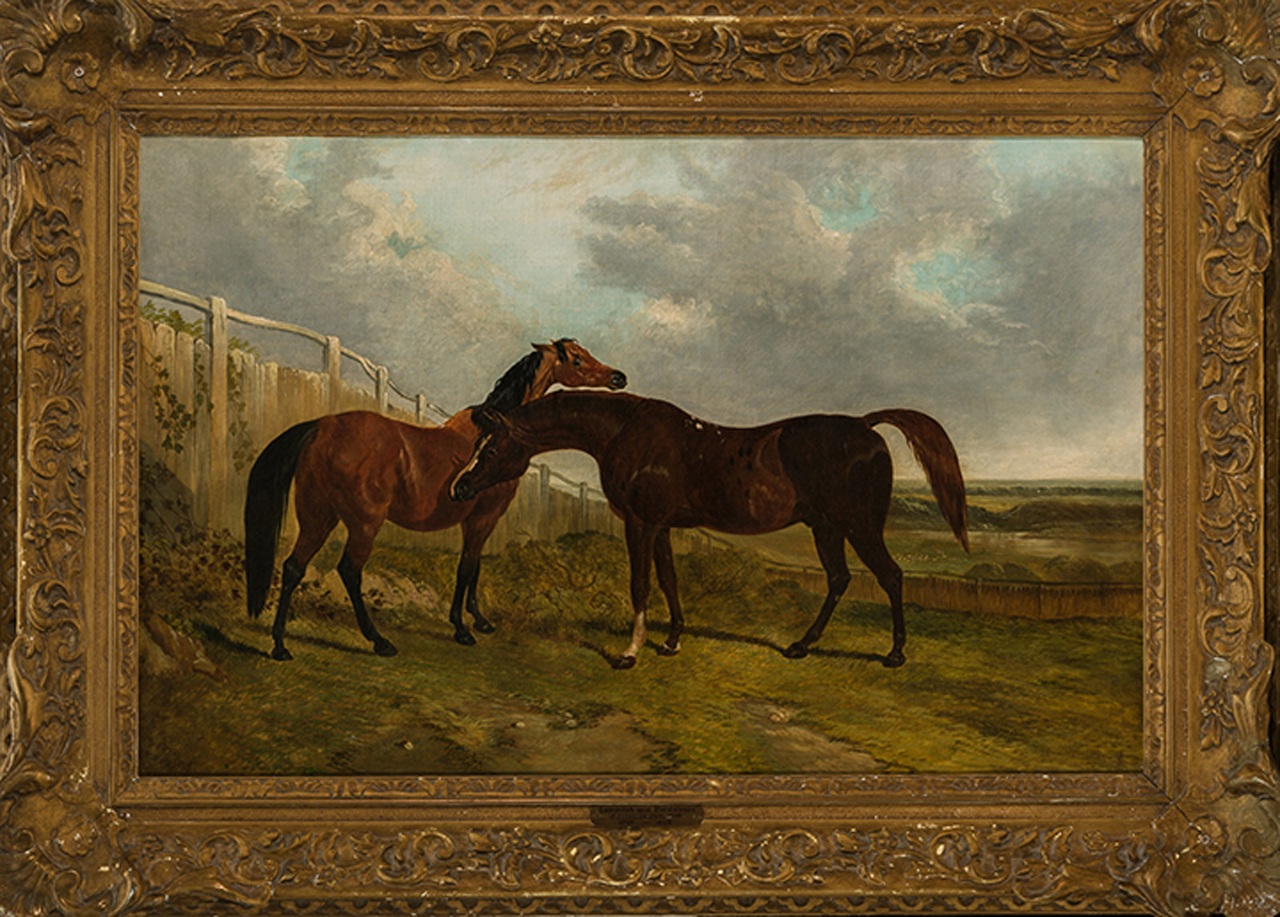2020 Fine Sporting Art, American Paintings, and Sculpture
23| John Frederick Herring Sr (British, 1795-1865)
Languish And Pantaloon
Signed, inscribed Languish & Pantaloon , dated 1846Provenance: Christie, Manson and Wood, May 5, 1864; 16 Herring Pictures owned by Messrs. Fores, obtained directly from the artist.Literature:O. Beckett, J.F. Herring and Sons, London: J. A. Allen andCompany, 1981. The Fores engraving of this painting isillustrated on page 166.Reproduced for Fores’ Series of the British Stud: Portraits ofCelebrated Stallions and Mares Whose Performance and Produceare well known on the Turf.This painting, Languish and Pantaloon, was described by TheSporting Review as portraits of a mare and a stallion, placed ina paddock and most naturally and characteristically grouped.The mare is the celebrated matron of the turf Languish, theproperty of the late Marquis of Westminster. She was bredby Mr. Bristow, by Cain, out of a Paynator mare; dam Lydiaby Poulton, out of Vanity. The horse is the well-known sirePantaloon, bred by Mr. Gifford, by Castrel, out of an Alexandermare, dam Idalia by Peruvian, out of Musidora. Pantaloononly raced at the age of 3, unbeaten in all seven starts. Whilehis victories were mostly against small fields in the country, hemade his mark at stud. With Pantaloon, Languish producedGhuznee, winner of the 1841 Epsom Oaks and CoronationStakes.The venerable Fores Gallery was unquestionably the topprintmaker in England at the time. Ruffs Guide to the Turfreported on the series: This admirable series painted byHerring and engraved by Harris is now in course of publication,and if aught were wanting to establish the reputation ofthe two artists, it would be found in these justly designatedmaster pieces. No sporting gallery has ever yet contained morebeautiful delineations of that noble animal, the horse, than areexhibited in these interesting portraits of the celebrities of theBritish Stud. The likenesses are preserved with the most strikingfidelity, the character perfectly life-like, and in the compositionof the pictures, beauty, grace, energy and animation aredisplayed with exquisite effect. Beckett lists the original paintings, by Herring, from which theengravings were produced, as being the property of Messrs.’Fores and as being sold at auction in 1864 by Christie, Mansonand Wood (the auction house that would eventually becomeChristie’s). Beckett includes an excerpt from The SportingMagazine: this matchless series of thoroughbreds makes theblood dance through one’s veins to think of the deeds of thesefavored of the seraglio, while to votaries of the Turf ‚Äî apartfrom the merit of these pictures as works of art, they are of greatimportance as preserving the portrait of the most celebrated ofthe blood present era. The quote chosen by Beckett demonstrates the views held bymany horsemen of the day ‚Äî the paintings by Herring serve agreater purpose than being attractive works of art. The worksserve as pictorial documentation of the greatest horses of anera ‚Äî a historical recollection for the generations of turfenthusiasts to come.The other notable sires and dams featured in this series includeSir Hercules and Beeswing, Touchstone and Emma, Cameland Banter, Muley Moloch and Rebecca, and Lanercost andCrucifix. These six sets of sires and dams pictured in TheBritish Stud
Oil on canvas, 20" x 31"
12000 - 15000
Signed, inscribed Languish & Pantaloon , dated 1846Provenance: Christie, Manson and Wood, May 5, 1864; 16 Herring Pictures owned by Messrs. Fores, obtained directly from the artist.Literature:O. Beckett, J.F. Herring and Sons, London: J. A. Allen andCompany, 1981. The Fores engraving of this painting isillustrated on page 166.Reproduced for Fores' Series of the British Stud: Portraits ofCelebrated Stallions and Mares Whose Performance and Produceare well known on the Turf.This painting, Languish and Pantaloon, was described by TheSporting Review as portraits of a mare and a stallion, placed ina paddock and most naturally and characteristically grouped.The mare is the celebrated matron of the turf Languish, theproperty of the late Marquis of Westminster. She was bredby Mr. Bristow, by Cain, out of a Paynator mare; dam Lydiaby Poulton, out of Vanity. The horse is the well-known sirePantaloon, bred by Mr. Gifford, by Castrel, out of an Alexandermare, dam Idalia by Peruvian, out of Musidora. Pantaloononly raced at the age of 3, unbeaten in all seven starts. Whilehis victories were mostly against small fields in the country, hemade his mark at stud. With Pantaloon, Languish producedGhuznee, winner of the 1841 Epsom Oaks and CoronationStakes.The venerable Fores Gallery was unquestionably the topprintmaker in England at the time. Ruffs Guide to the Turfreported on the series: This admirable series painted byHerring and engraved by Harris is now in course of publication,and if aught were wanting to establish the reputation ofthe two artists, it would be found in these justly designatedmaster pieces. No sporting gallery has ever yet contained morebeautiful delineations of that noble animal, the horse, than areexhibited in these interesting portraits of the celebrities of theBritish Stud. The likenesses are preserved with the most strikingfidelity, the character perfectly life-like, and in the compositionof the pictures, beauty, grace, energy and animation aredisplayed with exquisite effect. Beckett lists the original paintings, by Herring, from which theengravings were produced, as being the property of Messrs.'Fores and as being sold at auction in 1864 by Christie, Mansonand Wood (the auction house that would eventually becomeChristie's). Beckett includes an excerpt from The SportingMagazine: this matchless series of thoroughbreds makes theblood dance through one's veins to think of the deeds of thesefavored of the seraglio, while to votaries of the Turf — apartfrom the merit of these pictures as works of art, they are of greatimportance as preserving the portrait of the most celebrated ofthe blood present era. The quote chosen by Beckett demonstrates the views held bymany horsemen of the day — the paintings by Herring serve agreater purpose than being attractive works of art. The worksserve as pictorial documentation of the greatest horses of anera — a historical recollection for the generations of turfenthusiasts to come.The other notable sires and dams featured in this series includeSir Hercules and Beeswing, Touchstone and Emma, Cameland Banter, Muley Moloch and Rebecca, and Lanercost andCrucifix. These six sets of sires and dams pictured in TheBritish Stud
Signed, inscribed Languish & Pantaloon , dated 1846Provenance: Christie, Manson and Wood, May 5, 1864; 16 Herring Pictures owned by Messrs. Fores, obtained directly from the artist.Literature:O. Beckett, J.F. Herring and Sons, London: J. A. Allen andCompany, 1981. The Fores engraving of this painting isillustrated on page 166.Reproduced for Fores' Series of the British Stud: Portraits ofCelebrated Stallions and Mares Whose Performance and Produceare well known on the Turf.This painting, Languish and Pantaloon, was described by TheSporting Review as portraits of a mare and a stallion, placed ina paddock and most naturally and characteristically grouped.The mare is the celebrated matron of the turf Languish, theproperty of the late Marquis of Westminster. She was bredby Mr. Bristow, by Cain, out of a Paynator mare; dam Lydiaby Poulton, out of Vanity. The horse is the well-known sirePantaloon, bred by Mr. Gifford, by Castrel, out of an Alexandermare, dam Idalia by Peruvian, out of Musidora. Pantaloononly raced at the age of 3, unbeaten in all seven starts. Whilehis victories were mostly against small fields in the country, hemade his mark at stud. With Pantaloon, Languish producedGhuznee, winner of the 1841 Epsom Oaks and CoronationStakes.The venerable Fores Gallery was unquestionably the topprintmaker in England at the time. Ruffs Guide to the Turfreported on the series: This admirable series painted byHerring and engraved by Harris is now in course of publication,and if aught were wanting to establish the reputation ofthe two artists, it would be found in these justly designatedmaster pieces. No sporting gallery has ever yet contained morebeautiful delineations of that noble animal, the horse, than areexhibited in these interesting portraits of the celebrities of theBritish Stud. The likenesses are preserved with the most strikingfidelity, the character perfectly life-like, and in the compositionof the pictures, beauty, grace, energy and animation aredisplayed with exquisite effect. Beckett lists the original paintings, by Herring, from which theengravings were produced, as being the property of Messrs.'Fores and as being sold at auction in 1864 by Christie, Mansonand Wood (the auction house that would eventually becomeChristie's). Beckett includes an excerpt from The SportingMagazine: this matchless series of thoroughbreds makes theblood dance through one's veins to think of the deeds of thesefavored of the seraglio, while to votaries of the Turf — apartfrom the merit of these pictures as works of art, they are of greatimportance as preserving the portrait of the most celebrated ofthe blood present era. The quote chosen by Beckett demonstrates the views held bymany horsemen of the day — the paintings by Herring serve agreater purpose than being attractive works of art. The worksserve as pictorial documentation of the greatest horses of anera — a historical recollection for the generations of turfenthusiasts to come.The other notable sires and dams featured in this series includeSir Hercules and Beeswing, Touchstone and Emma, Cameland Banter, Muley Moloch and Rebecca, and Lanercost andCrucifix. These six sets of sires and dams pictured in TheBritish Stud
To Leave An Absentee Bid, Please Enter An Amount Below



